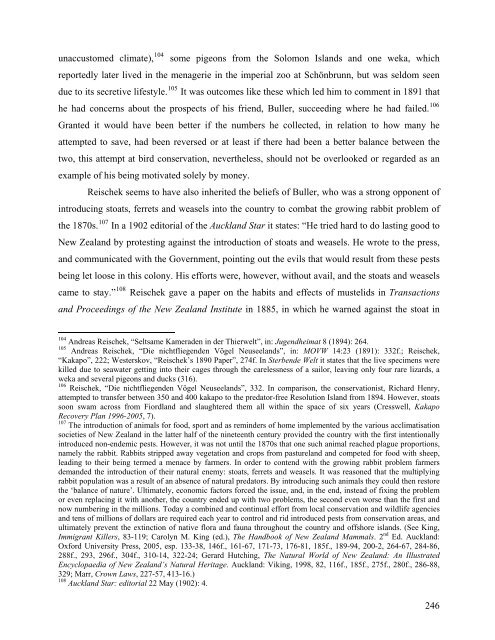General copyright and disclaimer - ResearchSpace@Auckland ...
General copyright and disclaimer - ResearchSpace@Auckland ...
General copyright and disclaimer - ResearchSpace@Auckland ...
You also want an ePaper? Increase the reach of your titles
YUMPU automatically turns print PDFs into web optimized ePapers that Google loves.
unaccustomed climate), 104 some pigeons from the Solomon Isl<strong>and</strong>s <strong>and</strong> one weka, which<br />
reportedly later lived in the menagerie in the imperial zoo at Schönbrunn, but was seldom seen<br />
due to its secretive lifestyle. 105 It was outcomes like these which led him to comment in 1891 that<br />
he had concerns about the prospects of his friend, Buller, succeeding where he had failed. 106<br />
Granted it would have been better if the numbers he collected, in relation to how many he<br />
attempted to save, had been reversed or at least if there had been a better balance between the<br />
two, this attempt at bird conservation, nevertheless, should not be overlooked or regarded as an<br />
example of his being motivated solely by money.<br />
Reischek seems to have also inherited the beliefs of Buller, who was a strong opponent of<br />
introducing stoats, ferrets <strong>and</strong> weasels into the country to combat the growing rabbit problem of<br />
the 1870s. 107 In a 1902 editorial of the Auckl<strong>and</strong> Star it states: “He tried hard to do lasting good to<br />
New Zeal<strong>and</strong> by protesting against the introduction of stoats <strong>and</strong> weasels. He wrote to the press,<br />
<strong>and</strong> communicated with the Government, pointing out the evils that would result from these pests<br />
being let loose in this colony. His efforts were, however, without avail, <strong>and</strong> the stoats <strong>and</strong> weasels<br />
came to stay.” 108 Reischek gave a paper on the habits <strong>and</strong> effects of mustelids in Transactions<br />
<strong>and</strong> Proceedings of the New Zeal<strong>and</strong> Institute in 1885, in which he warned against the stoat in<br />
104 Andreas Reischek, “Seltsame Kameraden in der Thierwelt”, in: Jugendheimat 8 (1894): 264.<br />
105 Andreas Reischek, “Die nichtfliegenden Vögel Neuseel<strong>and</strong>s”, in: MOVW 14:23 (1891): 332f.; Reischek,<br />
“Kakapo”, 222; Westerskov, “Reischek’s 1890 Paper”, 274f. In Sterbende Welt it states that the live specimens were<br />
killed due to seawater getting into their cages through the carelessness of a sailor, leaving only four rare lizards, a<br />
weka <strong>and</strong> several pigeons <strong>and</strong> ducks (316).<br />
106 Reischek, “Die nichtfliegenden Vögel Neuseel<strong>and</strong>s”, 332. In comparison, the conservationist, Richard Henry,<br />
attempted to transfer between 350 <strong>and</strong> 400 kakapo to the predator-free Resolution Isl<strong>and</strong> from 1894. However, stoats<br />
soon swam across from Fiordl<strong>and</strong> <strong>and</strong> slaughtered them all within the space of six years (Cresswell, Kakapo<br />
Recovery Plan 1996-2005, 7).<br />
107 The introduction of animals for food, sport <strong>and</strong> as reminders of home implemented by the various acclimatisation<br />
societies of New Zeal<strong>and</strong> in the latter half of the nineteenth century provided the country with the first intentionally<br />
introduced non-endemic pests. However, it was not until the 1870s that one such animal reached plague proportions,<br />
namely the rabbit. Rabbits stripped away vegetation <strong>and</strong> crops from pasturel<strong>and</strong> <strong>and</strong> competed for food with sheep,<br />
leading to their being termed a menace by farmers. In order to contend with the growing rabbit problem farmers<br />
dem<strong>and</strong>ed the introduction of their natural enemy: stoats, ferrets <strong>and</strong> weasels. It was reasoned that the multiplying<br />
rabbit population was a result of an absence of natural predators. By introducing such animals they could then restore<br />
the ‘balance of nature’. Ultimately, economic factors forced the issue, <strong>and</strong>, in the end, instead of fixing the problem<br />
or even replacing it with another, the country ended up with two problems, the second even worse than the first <strong>and</strong><br />
now numbering in the millions. Today a combined <strong>and</strong> continual effort from local conservation <strong>and</strong> wildlife agencies<br />
<strong>and</strong> tens of millions of dollars are required each year to control <strong>and</strong> rid introduced pests from conservation areas, <strong>and</strong><br />
ultimately prevent the extinction of native flora <strong>and</strong> fauna throughout the country <strong>and</strong> offshore isl<strong>and</strong>s. (See King,<br />
Immigrant Killers, 83-119; Carolyn M. King (ed.), The H<strong>and</strong>book of New Zeal<strong>and</strong> Mammals. 2 nd Ed. Auckl<strong>and</strong>:<br />
Oxford University Press, 2005, esp. 133-38, 146f., 161-67, 171-73, 176-81, 185f., 189-94, 200-2, 264-67, 284-86,<br />
288f., 293, 296f., 304f., 310-14, 322-24; Gerard Hutching, The Natural World of New Zeal<strong>and</strong>: An Illustrated<br />
Encyclopaedia of New Zeal<strong>and</strong>’s Natural Heritage. Auckl<strong>and</strong>: Viking, 1998, 82, 116f., 185f., 275f., 280f., 286-88,<br />
329; Marr, Crown Laws, 227-57, 413-16.)<br />
108 Auckl<strong>and</strong> Star: editorial 22 May (1902): 4.<br />
246















